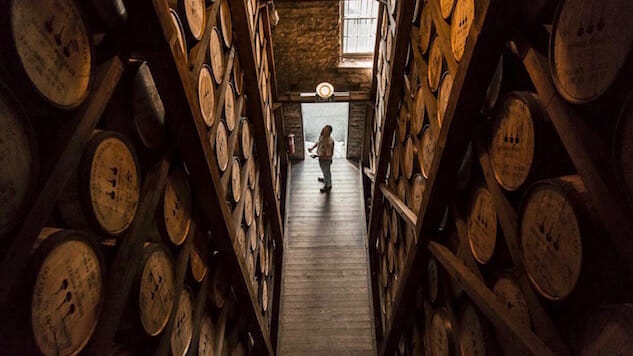Good Wood: How Whiskey Distillers Are Going Beyond American White Oak
Photo via Woodford Reserve/Facebook Drink Features
Whiskey enthusiasts often wax romantic about the balance of this mash bill, or the elegant neck of that copper pot still and sometimes even about exotic yeasts, and how these things play out in the flavor of their favored spirits. Yet it’s not these things, but the cask and the time spent in it that is the single biggest player in what whiskey tastes like.
According to Chris Morris, Master Distiller at Woodford Reserve, aging in new white oak barrels gives his bourbon “100% of its color naturally, and approximately 50 to 60% of its aroma and flavor.” For decades, the choice of wood used in whiskey casks was standardized. In America, it was almost all new white oak, as mandated by Federal law. In Scotland and Ireland, most of the casks were old barrels imported from America, plus a few types from Europe.
With whiskey around the world surging in popularity, the wood choices are now expanding, as producers reach for new sources of oak and sometimes other woods, and this reach is turning out new flavors.
Outside The Wood Bin
American whiskey’s first major steps away from traditional white oak were made by Maker’s Mark, which put French oak stave inserts into its barrels to produce Maker’s 46, and by Morris at Woodford Reserve, who produced a Masters Collection bourbon finished in sugar maple wood. This month, Seattle’s Westland Distillery took another step with its Garryana American Malt, made in part with whiskey aged in Garryana oak, a species native to Oregon and an all-new choice for whiskey barrels.
Compared to the standard white oak, with its sweet vanilla, “The flavor profile skews dark: molasses, clove, coffee grounds, blackberry jam, and wood smoke,” says Westland’s Master Distiller Matt Hoffman.
Same Tree, New Forest
Remember going to a national park as a kid, and seeing the sawn tree trunk on display, its rings indicating how old the tree was? Those rings tell you a lot more than just the age of the tree. The space between the rings, the grain, also tells you how favorable the climate was to the growth of the tree. That grain matters in whiskey barrels, too.
Most of the white oak used to age bourbon and rye whiskey in America comes from a swathe of states in the middle of the Eastern United States. Independent Stave Cooperage in Kentucky, a major barrel-maker, gets its wood from 12 states, but the two biggest are Kentucky and Missouri. Brown-Forman, maker of Jack Daniel’s and Woodford Reserve, owns its own cooperages, and most of its oak comes from “Tennessee, Alabama, Indiana and Missouri,” says their Supply Chain General Manager Larry Combs. The similar climates in these places yield trees with similar grains, creating standardized barrel oak.
Using oak from places with a shorter growing season, producing a tighter grain, constricts some of the flavors whiskey pulls from the wood as it ages, as some American craft distillers have discovered. Chicago’s FEW Spirits uses oak drawn from northerly Minnesota, and the tight grain of the Minnesota oak brings the wood spice and vanillin flavors drawn from the barrel more into balance, making the whiskey lighter on the vanilla and caramel.
Another whiskey using tighter oak is WhistlePig 15 Year Old Rye, finished for six months in barrels of Vermont oak harvested from the distillery property. As with FEW’s Minnesota wood, the tighter Vermont grain changes the balance of flavors coming out of the wood, in this case playing up the rye whiskey’s spiciness.
Across the Atlantic, the makers of Jameson reached outside the box last year to make their celebrated Midleton Dair Ghaelach, and in so doing they went in the opposite direction. Drawing on stocks of Irish pot still whiskey aged 15 to 22 years, Dair Ghaelach is then finished for 10 months in casks made of new Irish oak. Compared with its better-known cousins in France and Spain, Irish oak has a wide open grain, due to Ireland’s milder, wetter climate and long growing season. The result is a kind of super whiskey wood, allowing the spirit to pull heaps of flavors from the oak.
Little in whiskey-making looks as timeless as the barrel, lying in the warehouse year after year, waiting for the day its contents are mature. Now the whiskey boom is turning the old whiskey barrel on its head, and these new wood choices are just the first of what is to come. More new whiskey wood projects are already in the warehouses, holding whiskey, awaiting maturity and bottling.